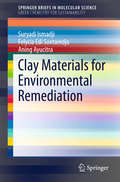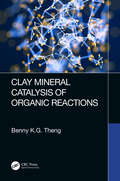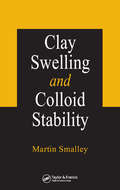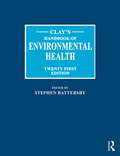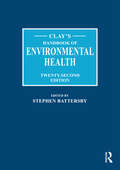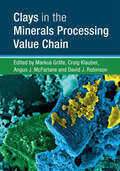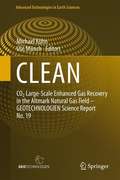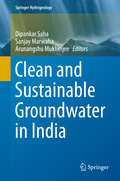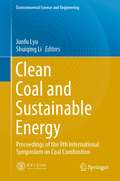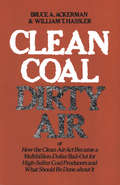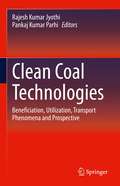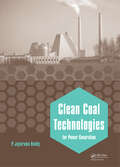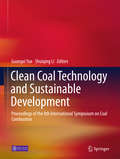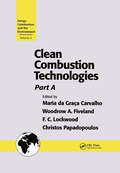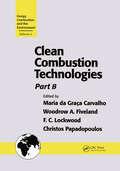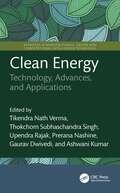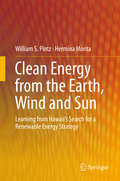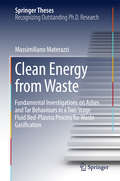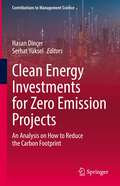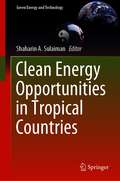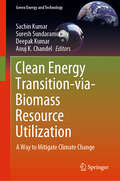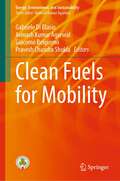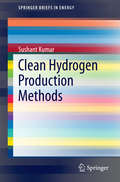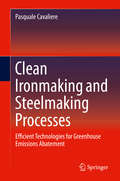- Table View
- List View
Clay Materials for Environmental Remediation (SpringerBriefs in Molecular Science)
by Suryadi Ismadji Felycia Edi Soetaredjo Aning AyucitraA comprehensive review of environmental remediation is presented with an emphasis on the role of clay minerals in water purification. In the first chapter, important aspects of environmental problems and possible solutions are discussed. In the second chapter, the application of natural clay minerals as environmental cleaning agents are explained. The discussion is focused on the role of different types of clay materials in hazardous substance removal from air, aqueous solutions, wastewater, aquaculture, ground water, etc. In the next chapter, the modification of clay materials is explored including the preparation of clay composite materials for environmental remediation. Various aspects of clay material modifications and the effects of clay surface chemistry on the removal of hazardous material is also discussed. Next, the equilibrium and kinetics of hazardous substance adsorption is presented. This chapter summarizes recent studies on the removal of hazardous substances from aqueous solutions and the environment using various types of clay minerals. The brief also includes various models used in adsorption studies and touches on the characterization of clay minerals.
Clay Mineral Catalysis of Organic Reactions
by Benny K.G. ThengThe book provides insight into the working of clays and clay minerals in speeding up a variety of organic reactions. Clay minerals are known to have a large propensity for taking up organic molecules and can catalyse numerous organic reactions due to fine particle size, extensive surface area, layer structure, and peculiar charge characteristics. They can be used as heterogeneous catalysts and catalyst carriers of organic reactions because they are non-corrosive, easy to separate from the reaction mixture, and reusable. Clays and clay minerals have an advantage over other solid acids as they are abundant, inexpensive, and non-polluting.
Clay Swelling and Colloid Stability
by Martin V. SmalleyIn a rare, over-the-shoulder perspective of a leading scientist's own breakthroughs, Clay Swelling and Colloid Stability puts emphasis on two significant paradigm shifts in colloid science that explain particle interactions for charged plates, stacks, suspensions, and pastes as well as spherical colloids. Martin Smalley first discusses th
Clay's Handbook of Environmental Health
by Stephen BattersbyClay’s Handbook of Environmental Health, since its first publication in 1933, has provided a definitive guide for the environmental health practitioner, or reference for the consultant or student. This 21th edition continues as a first point of reference, reviewing the core principles, techniques and competencies, and then outlining the specialist subjects. It has been refocused on the current curriculum of the UK’s Chartered Institute of Environmental Health but should also readily suit the generalist or specialist working outside the UK.
Clay's Handbook of Environmental Health
by Stephen BattersbySince its first publication in 1933, Clay’s Handbook of Environmental Health (under its different names) has provided a definitive guide for the environmental health practitioner (EHP), and an essential reference for the consultant and student. This 22nd edition continues with its more recent successful structure, reviewing the core principles, techniques, competencies and skills required of an EHP, and then outlining the specialist subjects without getting bogged down in a legalistic approach, seeking to broaden the content for a more global audience. This new edition seeks to educate the EHP on the public health impacts of global heating and the climate emergency and also reflects the COVID-19 pandemic, as might be expected. Although seeking to have global appeal, the impact of the UK leaving the EU is also addressed. The book examines environmental health in different settings, including in the military, working in both conflict and natural disaster settings, and environmental health at sea and airports. In line with previous editions, case studies are used to illustrate how EH problems have been resolved. This new edition includes guidance on key issues in public and environmental health including air pollution, contaminated land, housing and health, noise, water, food safety, pests and vector control, chemicals in the environment and radiation, as well as sustainability and public health and humanitarian crises. This handbook aims to give a basic understanding of the philosophical basis of environmental health, as well as the required technical aspects and an understanding of environmental health in different settings. All chapters have sections on further reading and sources of information. Clay’s Handbook is essential reading for all practitioners, students and researchers in environmental and public health wherever they are working.
Clays in the Minerals Processing Value Chain
by Robinson David J. Markus Gräfe Craig Klauber Mcfarlane Angus J.Clays are increasingly becoming a major problem in the mining, extraction and value-adding processes for a wide range of commodity raw materials. Clays can impact negatively on virtually every unit process within the mining and minerals processing sector, having long-term environmental implications that go well beyond the lifetime of the mining operation. This book is the first to compile, explain and evaluate the effects of clays in the mineral processing value chain, from mining to minerals processing, and finally, tailings disposal. Focusing on topics from the chemistry and rheology of clays to their detection and dissolution behaviour, this book provides comprehensive coverage of the effects on processes such as settling, preg-robing, flotation and comminution. It is an excellent reference for professional mineralogists and geologists, industrial engineers, and researchers interested in clays and clay minerals.
CLEAN: CO2 Large-Scale Enhanced Gas Recovery in the Altmark Natural Gas Field - GEOTECHNOLOGIEN Science Report No. 19 (Advanced Technologies in Earth Sciences)
by Ute Münch Michael KühnThe project CLEAN (CO2 Large-Scale Enhanced Gas Recovery in the Altmark Natural Gas Field) provides site specific knowledge for a potential future pilot project. This contributed volume gives an overview and final results of the entire project which is finalized to the end of 2012.
Clean and Sustainable Groundwater in India (Springer Hydrogeology)
by Dipankar Saha Sanjay Marwaha Arunangshu MukherjeeThe book embodies the groundwater issues and challenges in India focusing its sustainable use. It is a compilation of papers presented by the eminent experts from Government departments, academia, research institutes, NGOs and stakeholders who assembled at Kurukshetra on 21st August, 2015 in the event of Bhujal Manthan or "Churning of Groundwater" organized for the first time by Ministry of Water Resources, River Development and Ganga Rejuvenation, the apex Ministry of Water Resource under Government of India. India, as a country, is the highest groundwater extractor in the world. Its service towards attaining the food and clean drinking water security is well documented. This volume addresses the issues of aquifer characterization, groundwater contamination, groundwater resource availability and its sustainable management through community participation in pan-India scenario. This book provides a unique opportunity for its readers to understand groundwater domain in India in its entire gamut. The papers included in the volume were selected carefully from the presentations made in the following four broad topics during the Manthan; (i) groundwater quality, (ii) conjunctive use of surface and groundwater, (iii) management intervention and sustainable use of this resource, and (iv) groundwater problems and application of various techniques. The book contains 20 papers including an introductory chapter by the editors. The content of the book is enriched by contributions from eminent researchers and activists in groundwater domain, like Prof. Tushar Shah, Prof. Himanshu Kulkarni, Dr. D. K. Chadha, Dr. Bharat Sharma and others. The recommendations in the individual papers are of immense significance for keeping the groundwater of the country clean and sustainable. The volume will help the readers to understand the groundwater issues of the country and also assist policy makers to prepare strategies for its better governance and management with environmentally sustainable ways.
Clean Coal and Sustainable Energy: Proceedings of the 9th International Symposium on Coal Combustion (Environmental Science and Engineering)
by Junfu Lyu Shuiqing LiThis book gathers the proceedings of the 9th International Symposium on Coal Combustion, held in Qingdao, China in July 2019. It provides the latest research results on techniques for pulverized coal combustion and fluidized bed combustion, low-carbon energy and emission controls, and industrial applications. Highlighting research areas that are of great importance in promoting collaboration between related subjects and the technical development of coal-related fields, the book offers a valuable reference guide for researchers and engineers alike.
Clean Coal/Dirty Air
by Bruce Ackerman William T. HasslerA path-breaking effort in constitutional theory which brings a new clarity to the interpretation of the Fifth Amendment's just compensation clause. Essential reading for lawyers concerned with environmental regulation or the general development of constitutional doctrine.
Clean Coal Technologies: Beneficiation, Utilization, Transport Phenomena and Prospective
by Rajesh Kumar Jyothi Pankaj Kumar ParhiThis book presents the state of art of the several advanced approaches to beneficiation of coal. The influence of recent technology attains the advantages of processing coal, purification studies, rheological behavior, and the mineral beneficiation. The experts collected in this volume have contributed significantly to the enrichment in the in depth knowledge not only in context of working knowledge, but also future prospects of clean coal technology.
Clean Coal Technologies for Power Generation
by P. Jayarama ReddyThis book discusses clean coal technology (CCT), the latest generation of coal technology that controls pollutants and performs with improved generating efficiency. CCT involves processes that effectively control emissions and result in highly efficient combustion without significantly contributing to global warming. Basic principles, operational a
Clean Coal Technology and Sustainable Development: Proceedings of the 8th International Symposium on Coal Combustion
by Shuiqing Li Guangxi YueThis book gathers the proceedings of the 8th International Symposium on Coal Combustion. The contributions reflect the latest research on coal quality and combustion, techniques for pulverized coal combustion and fluidized bed combustion, special issues regarding CO2 capture (CCS), industrial applications, etc. - aspects that are of great importance in promoting academic communications between related areas and the technical development of coal-related fields. The International Symposium on Coal Combustion (ISCC), sponsored and organized by Tsinghua University since 1987, has established itself as an important platform allowing scientists and engineers to exchange information and ideas on the science and technology of coal combustion and related issues, and to forge new partnerships in the growing Chinese market. Researchers in the fields of clean coal combustion, carbon dioxide capture and storage, coal chemical engineering, energy engineering, etc. will greatly benefit from this book. Guangxi YUE, professor of the Department of Thermal Engineering in Tsinghua University, Beijing China, and a member of Chinese Academy of Engineering(CAE). Shuiqing LI, professor of the Department of Thermal Engineering in Tsinghua University, Beijing China.
Clean Combustion Technologies: Proceedings of the Second International Conference, Part A
by Maria da Graça Carvalho Woodrow A. Fiveland F. C. Lockwood Christos PapadopoulosThe seventy-five refereed papers in this volume represent the second in a series of biannual benchmarks for technologies that maximize energy conversion while minimizing undesirable emissions. Covering the entire range of industrial and transport combustion as well as strategies for energy R&D, these state-of-the-art contributions will be indispensable to mechanical and chemical engineers in academia and industry, and technical personnel in military, energy, and environmental agencies of government.
Clean Combustion Technologies: Proceedings of the Second International Conference, Part B
by Maria da Graca Carvalho Woodrow A. Fiveland F. C Lockwood Christos PapadopoulosThe seventy-five referenced papers in this volume represent the second in a series of biannual benchmarks for technologies that maximize energy conversion while minimizing undesirable emissions. Covering the entire range of industrial and transport combustion as well as strategies for energy R&D, these state-of-the-art contributions will be indispensable to mechanical and chemical engineers in academia and industry, and technical personnel in military, energy, and environmental agencies of government.
Clean Energy: Technology, Advances, and Applications (Advances in Manufacturing, Design and Computational Intelligence Techniques)
by Tikendra Nath Verma Thokchom Subhaschandra Singh Upendra Rajak Prerana Nashine Gaurav Dwivedi Ashwani KumarThe text discusses various technologies and methods that help in generating clean and renewable forms of energy. It also covers the use of fuels in energy conversion media such as internal combustion engines and compares these with existing fossil fuels. This book also focuses on green hydrogen revolution and the urban heat island effect.This book• covers topics such as sustainable biodiesel production, photovoltaic (PV) device optimization and performance enhancement, maximizing energy production, and improving the overall efficiency, reliability, and performance of solar energy systems.• explains energy‑efficient green buildings, blue–green infrastructure, high building energy demand, solar chimney, urban green spaces in reducing the urban heat island effect, urban air quality, building resilience to airborne pathogens, and challenges related to urban green infrastructure.• discusses the carbon sequestration potential of urban parks, the evolution of carbon capture, utilization, and storage (CCUS) technology, hydrogen production technologies, production and utilization of hydrogen as a future fuel for electric vehicles, and the evaluation of carbon emissions from various vehicles.• presents solar‑based thermal energy systems, optimizing solar air heater performance, and solar‑integrated hydrogen production and utilization in India.• illustrates agro‑residue‑derived biochar for environmental management and competing alternative fuel technologies for commercial vehicles in India.The book is primarily written for senior undergraduates, graduate students, and academic researchers in the fields of mechanical engineering, environmental engineering, energy engineering, electrical engineering, electronics and communications engineering, automotive engineering, and renewable energy.
Clean Energy from the Earth, Wind and Sun: Learning from Hawaii's Search for a Renewable Energy Strategy
by William S. Pintz Hermina MoritaThis book documents the socio-environmental context and early history of Hawaii's attempt to substitute renewable energy sources and energy efficiency measures for oil imports. It identifies areas of policy formulation where clean energy strategies were effective and areas where the state's policy strategy was either inappropriate or constrained by political or institutional factors. Although Hawaii's Clean Energy Initiative is a unique partnership, formulated to meet Hawaii's specific needs and resources, the policy process addressed problems that are common outside the state. While the case study involves clean energy policies, many of the issues are applicable to public policy development topics in other sectors. Examples of these "general interest" policy topics include: * understanding how the political and socioeconomic climate may influence policy assumptions * formulating a regulatory and legal framework for monitoring policy compliance * designing and understanding the implications of subsidy and tax-incentive policies * managing conflicts with policies in other sectors; * addressing the interests of existing and future stakeholders; * creating strategies for public consultation and information dissemination; * using external expertise from government agencies, academic institutions and private consultants; * designing performance and evaluation metrics for measuring progress. The book is intended for use in graduate and senior undergraduate courses dealing with the formulation, implementation and impact of public policy. It also provides researchers involved in the development and implementation of clean energy with a guide to the hurdles likely to be encountered in moving innovation from the technical sphere to the practical real world and how to overcome them. Professional policymakers may benefit from an example of a process to create a workable clean energy policy.
Clean Energy from Waste: Fundamental Investigations on Ashes and Tar Behaviours in a Two Stage Fluid Bed-Plasma Process for Waste Gasification (Springer Theses)
by Massimiliano MaterazziThis book explores the use of recent advanced multiple stage conversion technologies. These applications combine conventional fluidised bed systems with new plasma technologies to efficiently generate different energy outputs from waste materials with minimum cleaning effort. Using a mix of modelling and experimental approaches, the author provides fundamental insights into how the key operating variables of the two-stage process may impact the final quality of syngas. This thesis serves as a useful reference guide on the modelling and design of single and multiple-stage systems for thermal waste treatment. Its extended section on plant configuration and operation of waste gasification plants identifies the main technical challenges, and is of use to researchers entering the field.
Clean Energy Investments for Zero Emission Projects: An Analysis on How to Reduce the Carbon Footprint (Contributions to Management Science)
by Hasan Dinçer Serhat YükselThis contributed volume analyses and discusses how atmospheric carbon emissions can be prevented using carbon capture and removal technology and how renewable energies can be used to reduce carbon emissions. Both approaches have their disadvantages. First of all, both involve high costs. Secondly, both require the use of advanced technology. As a result, many countries continue to use fossil fuels. The book seeks to address these problems by identifying strategies to increase countries’ use of clean energy. The authors discuss the dilemmas of zero emission and competition in the energy industry and illustrate cross-country applications of the current trends in the form of zero-emission business projects.
Clean Energy Opportunities in Tropical Countries (Green Energy and Technology)
by Shaharin A. SulaimanThis book highlights the present scenario of energy demand and power generation technologies in tropical countries. The tropics are well known to receive direct sunlight. Furthermore, different than four-season countries, tropical countries have a continuous summer-like season, and therefore, they are rich in clean energy sources, like solar and biomass. Home to 40% of the world’s population, the demand for energy in these countries keeps increasing. With the present serious global concern on the environment, the choice of power generation is no doubt the cleanest possible resources. This book delves into the opportunity that various tropical countries have in pursuing environmentally friendly power generation systems.
Clean Energy Transition-via-Biomass Resource Utilization: A Way to Mitigate Climate Change (Green Energy and Technology)
by Sachin Kumar Suresh Sundaramurthy Deepak Kumar Anuj K. ChandelThis book highlights clean energy transition via sustainable utilization of biomass resources, viz. forestry, agriculture, agroforestry, grassland, and seaweeds to climate change mitigation. Bioresources have tremendous potential to mitigate global warming. Also, biomass is expected to play a multifunctional role including food production, source of energy and fodder, biodiversity conservation, and yield of goods and services to the society. It brings together perspectives of various communities involved in the research and regulation of bioenergy deployment in the context of climate change mitigation. The book presents the way forward to policy makers and stakeholders involved with bioenergy development. This development may be directive challenges in the transport sector where options such as hydrogen and electric vehicles relying on hydro, wind, and solar PV will require decades to become established on a substantial scale. Furthermore, meeting ambitious climate change targets will also require environment-friendly fuels in air and marine transport where no alternative to biofuels is currently available. The process design-via-onion model for sustainable utilization of biomass resources is also one of the most important subjects of the book. This book includes state-of-the-art approaches on bottlenecks and circular economy analysis for biomass energy use to reduce climate change and sustainability frameworks to guide bioenergy development.
Clean Fuels for Mobility (Energy, Environment, and Sustainability)
by Gabriele Di Blasio Avinash Kumar Agarwal Giacomo Belgiorno Pravesh Chandra ShuklaThis book provides an overview of clean fuels for sustainable mobility by highlighting on world energy outlook, technic-economic assessment, and the key aspects of the fuel production processes and their possible large impact on various transportation sector segments. The content initially deals with different types of alternative fuels, for example, ethanol, methanol, butanol, hydrogen, biogas, biodiesel, etc. It also focuses on current trends in the automotive sector. Various aspects of the clean fuels production process and formulation to improve the combustion characteristics and efficiency toward sustainability are considered. Some of the important fuels like hydrogen, ammonia, natural gas etc. are discussed in detail. This volume will be useful for the industrial and research community involved in fuels, combustion engines, and environmental research.
Clean Hands: A Novel
by Patrick HoffmanA New York Times Book Review Summer Thriller Pick. &“Keep your eye on Patrick Hoffman—he&’s got the right stuff.&”—James Carlos Blake Corporate lawyer Elizabeth Carlyle is under a lot of pressure. Her prestigious New York law firm is working on the most high-stakes case in company history, defending a prominent bank. When Elizabeth gets the news that one of her junior associates has lost his phone—and the secret documents that were on it—she needs help. Badly. Enter ex-CIA officer Valencia Walker, a high-priced fixer who gets called in when governments, corporations, and plutocrats need their problems solved discretely. But things get complicated when the missing phone is retrieved: somebody has already copied the documents, and now they&’re blackmailing the firm. When the situation gets murkier still—hinting that darker forces may be churning below the surface—Elizabeth and Valencia must maneuver and outmaneuver whomever is behind this, and, most importantly, keep their hands clean. This is a world of private security, private diplomacy, and private justice. A sharply drawn cast of characters—dirty lawyers, black-market traders, Russian criminals, and extra-judicial actors, all take part in this breakneck tour through New York. Authentic, tense, and impossible to put down, Clean Hands gives a vivid look at the connections between corporations, government, and the underworld. &“It becomes increasingly clear that the whole thing is far more complicated, with much higher stakes, than most of the pawns in this grand chess game understand. The fun is in the details.&”—The New York Times Book Review
Clean Hydrogen Production Methods (SpringerBriefs in Energy)
by Sushant KumarThis brief covers novel techniques for clean hydrogen production which primarily involve sodium hydroxide as an essential ingredient to the existing major hydrogen production technologies. Interestingly, sodium hydroxide plays different roles and can act as a catalyst, reactant, promoter or even a precursor. The inclusion of sodium hydroxide makes these processes both kinetically and thermodynamically favorable. In addition possibilities to produce cleaner hydrogen, in terms of carbon emissions, are described. Through modifications of steam methane reformation methods and coal-gasification processes, from fossil as well as non-fossil energy sources, the carbon dioxide emissions of these established ways to produce hydrogen can significantly be reduced. This brief is aimed at those who are interested in expanding their knowledge on novel techniques and materials to produce clean hydrogen and capture carbon dioxide at a large-scale. The detailed thermodynamic analysis, experimental findings and critical analysis of such techniques are well discussed in this brief. Therefore, this book will be of great interest and use to students, engineers and researchers involved in developing the hydrogen economy as well as mitigating carbon dioxide emissions at a large-scale.
Clean Ironmaking and Steelmaking Processes: Efficient Technologies for Greenhouse Emissions Abatement
by Pasquale CavaliereThis book describes the available technologies that can be employed to reduce energy consumption and greenhouse emissions in the steel- and ironmaking industries. Ironmaking and steelmaking are some of the largest emitters of carbon dioxide (over 2Gt per year) and have some of the highest energy demand (25 EJ per year) among all industries; to help mitigate this problem, the book examines how changes can be made in energy efficiency, including energy consumption optimization, online monitoring, and energy audits. Due to negligible regulations and unparalleled growth in these industries during the past 15-20 years, knowledge of best practices and innovative technologies for greenhouse gas remediation is paramount, and something this book addresses.Presents the most recent technological solutions in productivity analyses and dangerous emissions control and reduction in steelmaking plants;Examines the energy saving and emissions abatement efficiency for potential solutions to emission control and reduction in steelmaking plants;Discusses the application of the results of research conducted over the last ten years at universities, research centers, and industrial institutions.
